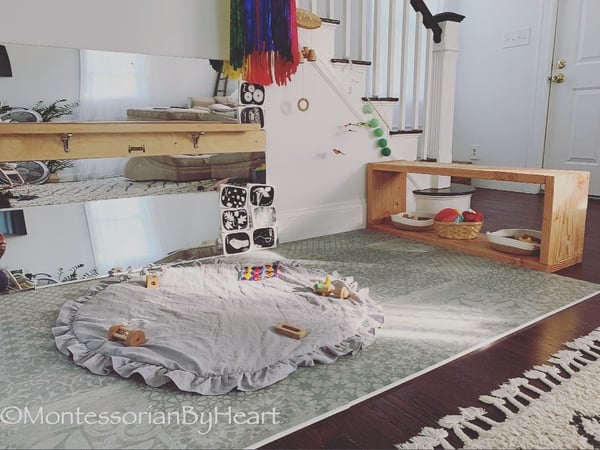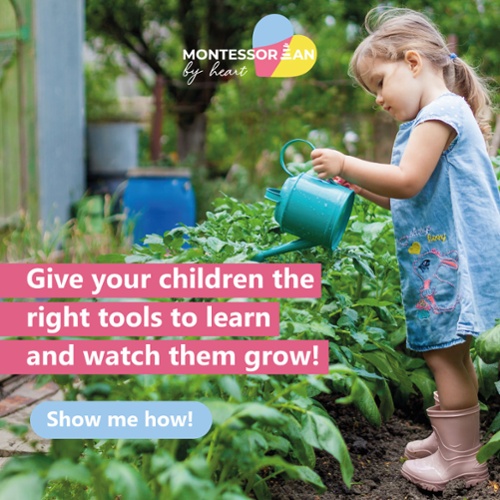Wondering how you can set up your home the Montessori way affordably? If you are an infant or toddler parent, let me put your mind at ease. First, it doesn’t require a substantial investment nor many things.
Second, the whole purpose of a Montessori playroom is to foster baby and toddler independence, so it must be child-centered; everything in the play area has a purpose. Learn what the must-haves are and why.
What Makes a Space Montessori?
A Montessori playroom is designed to allow children to be independent while playing. What does that mean? How can you have one at home? Here’s a list of must-haves that will make you a proud Montessori parent :)
1. Low shelf
For a baby, the toys need to be on a lower storage shelf or on the floor. For a toddler, a one-level shelf will do. You don’t need fancy furniture; you can make it or use carton boxes, even out from a shoe rack!
Put the shelf in the space where you want your child to play; it can be in the living room or any area you’ll spend most of the time. That’s what I did! The picture featured in this post is a real Montessori playroom: mine! My husband made the shelf :)

2. Just A Few Toys and Materials
Make sure to place the right number of toys according to your child's age; the Montessori philosophy is adamant about this. There’s an amount for every age, so make sure to check my list of toys and materials depending on your child’s interests and age.
In the Montessori baby environment, place a few things for them to discover; mobiles to develop visual tracking, binocularity and effectively switching the gaze between objects. You can also prepare discovery baskets with 5-7 items that you want your child to explore. You can place safe kitchen items, teethers, bathroom safe items, animals, baskets of colors, instruments and make sure everything is safe.
Of course, you’ll have to hand the toys to babies at times, but as they grow older, little by little, they will figure out where the toys go; make sure that you model putting them there.

In the case of toddler playrooms, there’s usually a shelf with two levels so you can place more materials for them to interact with. I recommend that you put a material from each area of the curriculum.
3. Mat or table to work
You can place a mat or a rug to make the space beautiful and safe, so they can move freely without hurting themselves. Sometimes your child will sit and land on its back and tumble many times, so the rug will soften the fall. A table will allow toddlers to work comfortably with materials from all areas of the curriculum.

4. A Mirror
You can get an inexpensive acrylic mirror for your child. I recommend you to place it at floor level so your child can see its reflection and also discover the room through the mirror.

5. Baskets and trays
For babies, let them explore items in small baskets. As they grow into toddlerhood, start using comfortable trays with handles on the sides.
Start adding one or two items on them and add more once the child has more control of their hands. Some Montessori teachers use Velcro on the bottom of some items, like cups, so they don’t spill, but it’s entirely up to you!

What Goes On The Shelf?
Let’s say you’ve set up a beautiful, cozy space for your child to play and do Montessori activities; a mat, a mirror, a shelf, and all. What does your child play with?
Place materials from all the areas of the Toddler Montessori curriculum:

Practical Life
These activities are reflective of every day “work” that adults do. The materials and tools are real and purposeful, inviting the child to familiar chores. This area helps develop independence, coordination, concentration, and order. To set up this space you need materials and space for food preparation, cleaning, and doing household chores. Items that help them develop skills like pouring, wiping, hammering, etc. In fact, one of the materials included in the Montessori Time Box is an eye dropper that allows the child to use the pincer grasp and release water, therefore building fine motor skills.
Sensorial/Manipulatives
The sensorial area of the Montessori curriculum is intended to enrich the child's perception of sight, sounds, touch, smell, and taste. Through the use of these materials the child can fine-tune their senses and develop a better sense of its world.
Math
The Math area of the Montessori curriculum is intended to allow the child to develop an understanding of mathematical concepts through the use of beautiful and concrete materials.
Language
The Montessori Language curriculum is an invitation for children to learn language using their senses. The materials provide a rich language foundation and prepares them for the language work that they will come in contact with in their near future.
For babies, you can start with discovery baskets with safe objects from around the house. For toddlers, you can introduce smaller objects like animals, tools, home, bathroom, community helpers to increase their language and vocabulary.
In the Montessori classroom we always use the "Three Period Lesson" to teach a language lesson. For a baby, start by showing the objects and saying the name out loud: "This is a pig, this is a horse" and so on. For a toddler, I would recommend you to only apply the first two stages of the Three-Period Lesson, which are:
- Naming : This is a horse.
- Recognizing: Show me the horse.
I wouldn't recommend using the Third Period, which is Remembering — "What is this?” —until you see that the toddler feels confident enough to start naming the material on its own.
Art & Movement
Children express their feelings with art and Movement. In the Montessori environment it is important to provide open-ended art and movement activities to help children explore and use their creativity.
Start small with one or two watercolors and then increase the number little by little. If you have an easel, show them how to independently paint with their fingers and brushes. Always have play dough and a sensory bin close by to put different sensorial items inside and change them every few weeks. They will love it!
Why All This?
All the materials in the Montessori curriculum aim to work one skill at a time; to pour, transfer, etc. That’s the main difference between Montessori materials and other toys that make noise or are flashy.
These materials are usually natural and placed in little baskets or trays. The child can independently use them and place them back while learning order and organization, one of the 5 Montessori techniques that follow the child's sensory period of order.
Also, all Montessori materials have control of error, which means children can use them on their own. They will figure it out and correct themselves.
Under this philosophy, you never correct the child. You want it to come from him or her. Ok, what if they don't realize there’s something incorrect? You can always guide them; for example, say “hey, there’s a toy left in the basket or tray, I'm wondering why.” And then the child will acknowledge it. That’s the magic of Montessori!
Teach your children to use the materials and toys following the Montessori Work Cycle:
- Choose a material
- Get it from the shelf.
- Place it in the rug or table
- Work with the materials.
- Clean up
- Put them away once they are done.
I know, some toddlers reject the idea of “cleaning ” at first, so you must offer them the choice of doing it by themselves or with you; at the end of the day, they have to do it, so they understand that is important.
Above All, Keep It Simple
Less is more in the Montessori approach. So, don’t overcrowd your child’s environment with too much furniture, colors or bins full of toys. Everything must be simple, beautiful and easy accessible to promote independence.
Whatever space you choose in the house make sure has a lot of natural light.
Neus Carmona
Loving Mom and Montessori trained teacher. I bring a real Montessori education experience to your home.
